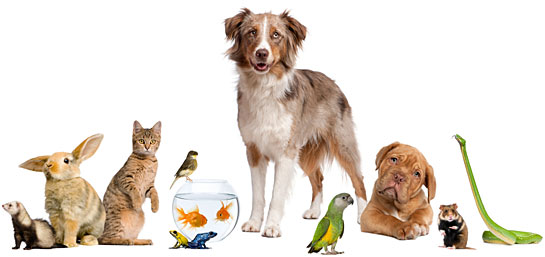

“The love of all living creatures
is the most noble attribute of man.”
Charles Darwin
Courtesy of Eredus:
“After you have exhausted what there is
in business, politics, conviviality, and so on –
have found that none of these finally satisfy,
or permanently wear – what remains?
Nature remains.”
Walt Whitman
Courtesy of BBC Earth:
Courtesy of Sustainable Human:
HUGH LOFTING
1886 – 1947

Doctor Dolittle, one of the best-loved characters in children’s literature, was born in the mud and blood of the Flanders trenches in World War I. His creator, Hugh Lofting, was appalled by the casual cruelties inflicted on the horses that worked and died so bravely in the front lines. Despairing of man’s inhumanity, Lofting imagined a world in which he could talk to the animals and ask them about their joys and sorrows.
“Imagine” by John Lennon, performed by Emeli Sandé:

In his weekly letters home to his two small children, he invented a doctor who lived in the peaceful English village of Puddleby-on-the-Mash. He called him Dolittle – the nickname he’d given his son Colin. Doctor Dolittle lost his patients because he kept so many pets. So, instead, he cared for the animals, who taught him their language.
“Talk To The Animals” (courtesy of NewportTheatreGuild):
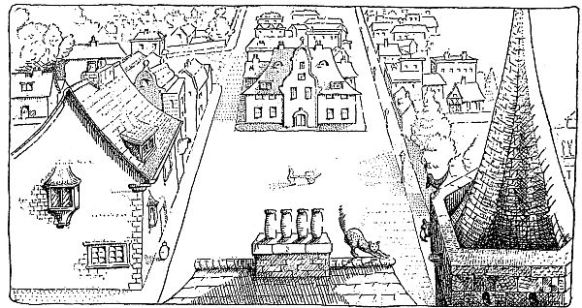
Second Lieutenant Lofting read parts of these stories by candlelight to his fellow soldiers in the trenches. One told Colin years later that they had saved his sanity. Around the edges of the letters, Lofting sketched his unassuming hero – a portly, rather unkempt figure in a frock coat and top hat.

This endearing figure – thoughtful, scholarly, and impractical – could have been created by a rural vicar. But Lofting, a dark, brooding man of Irish stock, had a more colourful life. He was born in Maidenhead in 1886, the youngest of six children. His father, a clerk of works, made it clear to the young boy that writing was not a man’s career.
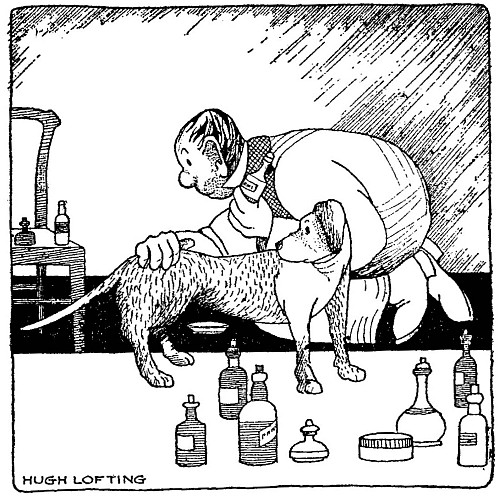
So Lofting left home, qualifying as a civil engineer in Boston and London and spending the next five years prospecting in Canada and building railways in West Africa and Havana. He returned to the US where he married an American debutante, Flora Small, and settled in New York City to turn his hand to writing stories. It was a gamble. Their first child, Elizabeth, was born in 1913. The short stories he wrote were published in magazines but barely paid the bills.
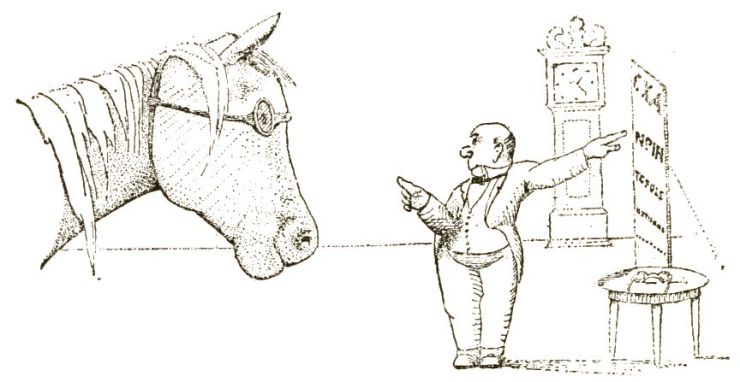
Then came World War I. After working for the British Ministry of Information in New York, Lofting was commissioned into the Irish Guards. In 1918, wounded and sent home, he found that Flora had kept his letters. Back in New York, he decided to turn them into a book. If there was one thing Lofting had in common with Dr Dolittle, it was his deep love of animals. As a boy in Maidenhead, he had maintained a small zoo and a natural history museum in the back of a linen cupboard until his mother found it after following a trail of white mice.
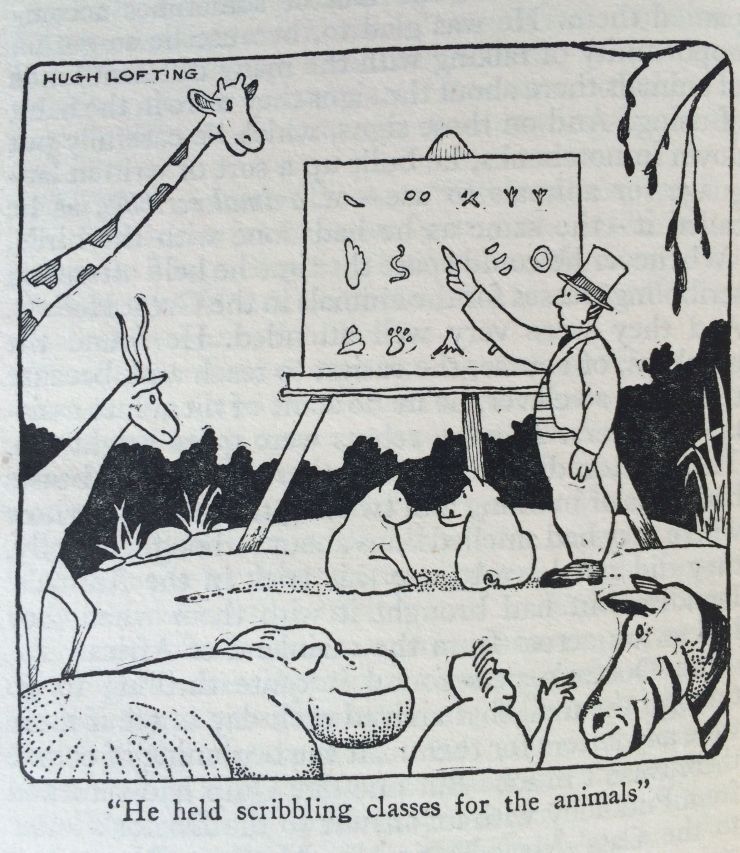
Lofting’s youngest, Christopher, recalled taking home baby birds that had fallen out of their nests. With anybody else, they would have died within hours. But his father would put the bird under a lamp, feed it with a pipette or a matchstick, and six weeks later he would open a window and the bird would fly out.
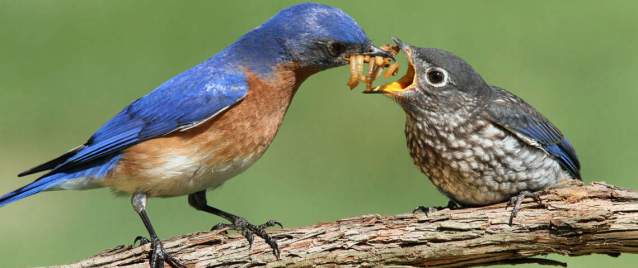
Courtesy of Kinder World:
The Story of Doctor Dolittle
In the Dolittle books, Lofting imbued that love of the animals in millions of his young readers by the brilliantly simple stratagem of creating the one man who was allowed to learn their language. The first, The Story of Doctor Dolittle, was published on both sides of the Atlantic to huge and immediate success.
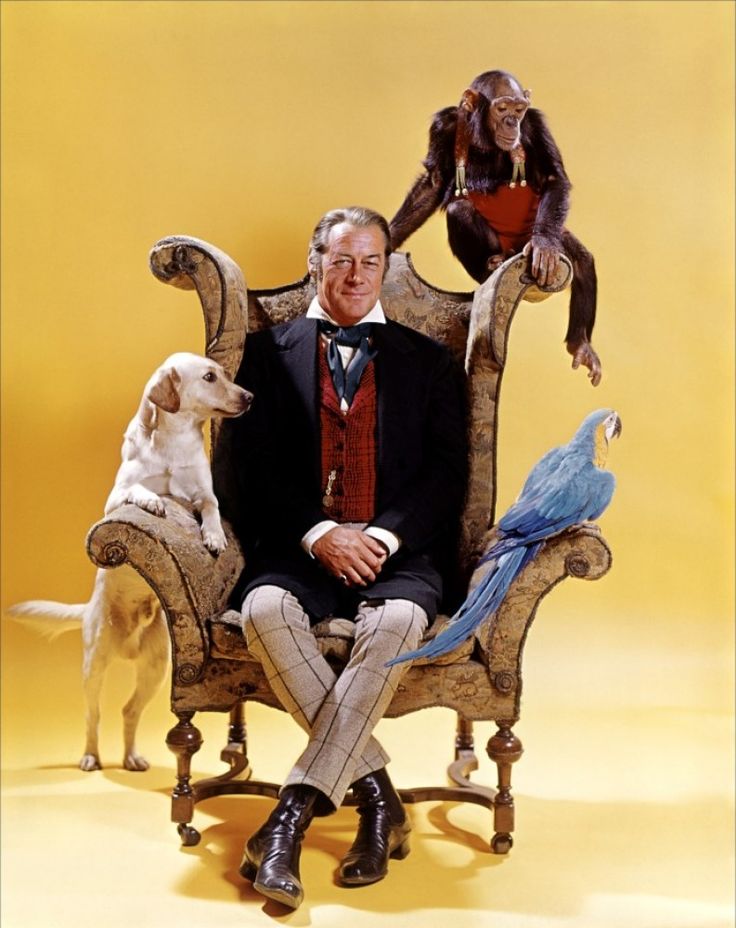
The glorious opening sequence from the 1967 film “Doctor Dolittle” (courtesy of Jacob Coronado):
In this and the subsequent Dolittle adventures, he created a delightful menagerie of animal characters: Polynesia, the short-tempered parrot, the double-headed Pushmi-Pullyu, Dab-Dab, the duck, and Gub-Gub, the pig, and the caterpillar as long as a village street, with gout in a dozen of its feet, Jip, the dog, and the owl, Too-Too. In many books, the narrator is young Tommy Stubbins, the Doctor’s apprentice and wide-eyed admirer.
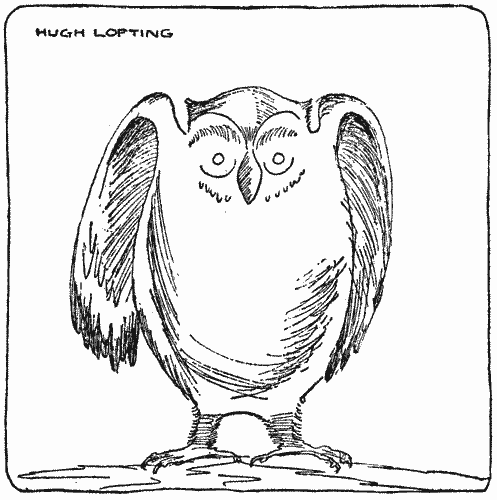
“The Carnival of the Animals: X. Aviary” by Camille Saint-Saëns (courtesy of Arpege’s Music):
Lofting won prestigious literary awards during his lifetime, but Dr Dolittle became a millstone around his neck. He had drunk quite heavily since being invalidated out of the army in 1918. This turned towards alcoholism as his wife Flora succumbed to mental illness. She died in 1927, and the following year he married New Yorker, Katherine Peters. Two weeks after their wedding, she died from pneumonia contracted on their honeymoon.
“The Last Rose of Summer” (Irish Traditional), performed by Barry Douglas, piano, and Eimear McGeown, Irish flute:
Doctor Dolittle on the Moon

A few months later he published a Doctor Dolittle novel that stranded him on the Moon – his effort to dispose of his hero. Alcoholism and grief pitched him into manic depression. But public pressure was such that in 1933 he was forced to bring Dolittle back. In the last four books, the gentle Doctor becomes Lofting’s mouthpiece to express his discontent with the modern world, its materialism, and heedlessness.

In 1935 he married for the third time, to a young nurse half his age. They moved to California, where he found happiness. But the outbreak of World War II redoubled his pessimism. Turned down by the Irish Guards when he attempted to re-enlist, he started drinking again and eventually died of liver failure in 1947, aged 61.
“Piano Concerto No. 1 in E-Flat Major”, H. 27: II. by John Field, performed by Míċeál O’Rourke and London Mozart Players:

Lofting bequeathed to the world one of the imperishable characters of children’s fiction – the subject of three Hollywood films, one starring Rex Harrison and another, Eddie Murphy, and a stage musical. Doctor Dolittle’s books are as enthralling as ever.

“Books teach you to conquer the world with your love!”
Dr Manoj Bhambu
The Voyages of Doctor Dolittle
The Voyages of Doctor Dolittle is the second book in Hugh Lofting’s beloved series about a very kind doctor who can talk to animals and the one that most happily conveys the richness of the author’s invention. If the doctor’s linguistic wizardry weren’t entertaining enough, he also has a habit of falling into fanciful adventures in the company of his pets, whom I have mentioned previously.
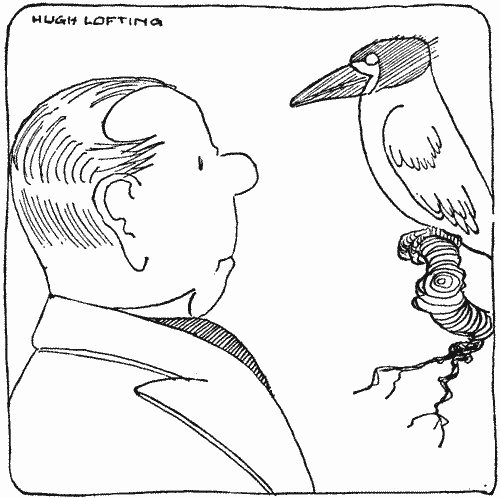
Courtesy of TED-Ed:
The narrator, the young boy Tommy Stubbins gives the account of what is going on in Dolittle’s household and on the epic journey from their home base in the village of Puddle-by-on-Marsh to the floating atoll called Spidermonkey Island, where they hope to examine the rare Jabizri beetle. In the course of their travels, Dolittle and company brave a shipwreck, encounter the Great Glass Sea Snail, and solve the mystery of the disappearance of the great naturalist known as Long Arrow.

Throughout, Lofting’s wit and warmth, and the beautifully realised characters, human and animal, provide a happy counterpoint to the compelling story of their perilous escapades, making The Voyages of Doctor Dolittle a perfect vehicle in which to explore the pleasure and promise of wonderful storytelling.
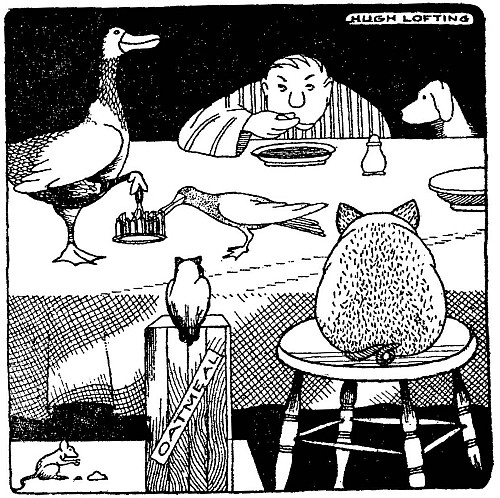
An extract from The Story of Doctor Dolittle:
“Once upon a time, many years ago – when our grandfathers were little children – there was a doctor and his name was Dolittle – John Dolittle, M.D. It means that he was a proper doctor and knew a whole lot. He lived in a little town called Puddleby-on-the-Marsh. All the folks, young and old, knew him well by sight. And whenever he walked down the street in his high hat everyone would say, ‘There goes the Doctor! He’s a clever man.’

And the dogs and the children would all run up and follow behind him; and even the crows that lived in the church tower would caw and nod their heads. The house he lived in, on the edge of the town, was quite small, but his garden was very large and had a wide lawn and stone seats and weeping willows hanging over. His sister, Sarah Dolittle, was the housekeeper for him, but the Doctor looked after the garden himself.

He was very fond of animals and kept many kinds of pets. Besides the goldfish in the pond at the bottom of his garden, he had rabbits in the pantry, white mice in his piano, a squirrel in the linen closet, and a hedgehog in the cellar. He had a cow with a calf too, and an old lame horse – twenty-five years of age – and chickens and pigeons and two lambs and many other animals. But his favourite pets were Dab-Dab, the duck; Jip, the dog; Gub-Gub, the baby pig; Polynesia, the parrot; and the owl, Too-Too.
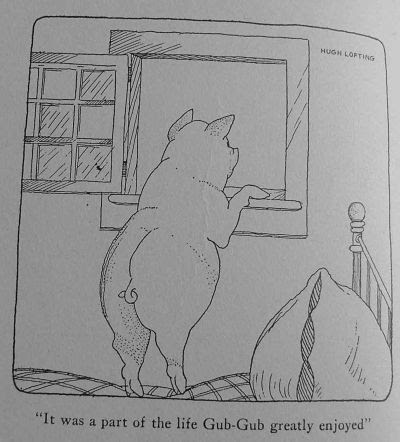
His sister used to grumble about all these animals and said they made the house untidy. And one day when an old lady with rheumatism came to see the Doctor, she sat on the hedgehog, who was sleeping on the sofa, and never came to see him more, but drove every Saturday all the way to Oxenthorpe, another town ten miles off, to see a different doctor.
‘Surely, Dab-Dab,’ said he, ‘we have some cockroaches!’

Then his sister, Sarah Dolittle, came to him and said,
‘John, how can you expect sick people to come and see you when you keep all these animals in the house? It’s a fine doctor would have his parlour full of hedgehogs and mice! That is the fourth personage these animals have driven away. Squire Jenkins and the Parson say they wouldn’t come near your house again – no matter how ill they are. We are getting poorer every day. If you go on like this, none of the best people will have you for a doctor.’
‘But I like the animals better than the ‘best people,’ said the Doctor.
‘You are ridiculous,’ said his sister and walked out of the room.
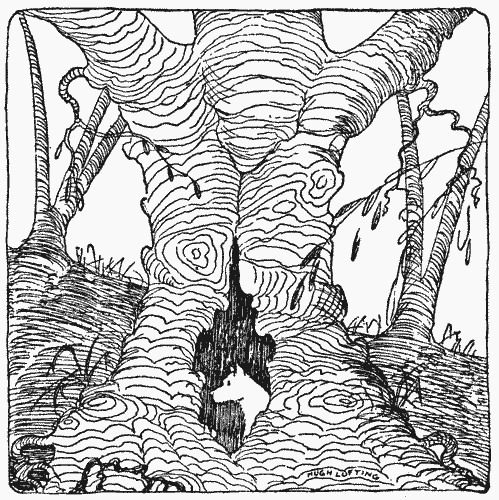
Courtesy of Christopher Szafran-Luce:

Thanks for this lovely, informative post about one of my childhood favourites! Hugh Lofting was a genius! The movies have lost their appeal for me but the books haven’t. One of my terms of endearment for my children and dog is Tommy Stubbins!
LikeLike
Thank you so much for your wonderful comments! As I admire everything you write, your words are greatly appreciated.
If you love the great Tagore the book post number 1 will please you.
Joanna
LikeLiked by 1 person
I do love Tagore, his Rabindra Sangeet more than his writings. I’ll certainly go over and read that post. Thank you!
LikeLike
Thank you! I love him from my childhood and his books are on my desk. Also, please look up the two posts about the greatest scientific discoveries in India and about Ramanujan.
Joanna
LikeLike
Can you believe it? A veterinarian who has never read any Dr. Doolittle! I did see one of the movies though and it was a lovely fantasy. Stewart
LikeLike
Thank you, Stewart, for your comment. This type of fantasy is very popular, just think of The Jungle Book!
Joanna
LikeLike
Yes, the Jungle Books made into movies by Disney are one type of fantasy. However, I enjoyed much more those by Rudyard Kipling which were read to me by my grandfather, “Papa”, as I sat in his lap and where the fantasy came straight from my imagination. Stewart
LikeLike
Thank you, Stewart, when you get to part 29 you will read all about Kipling, his works, the Nobel Prize, and the tragedies that destroyed his life.
Joanna
LikeLike